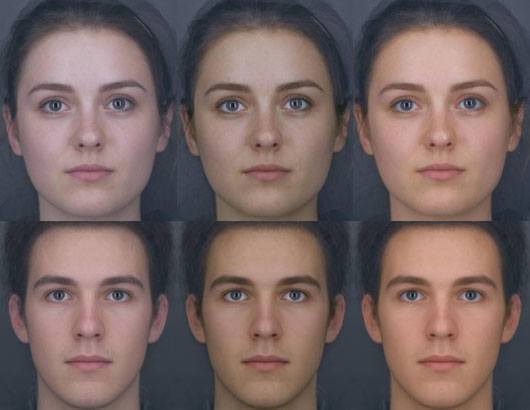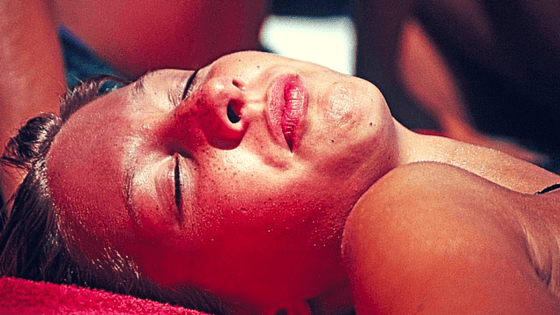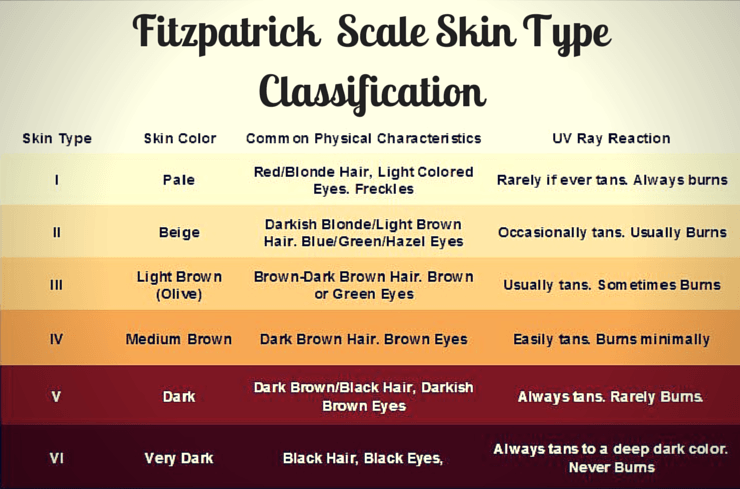We all know why too much sun (and as a result UV radiation) isn’t the best thing for our skin. Especially in the long run.
Most people know that the sun and tanning beds are damaging their skin but it doesn’t stop them from tanning because… well let’s be honest here it’s the easiest way of improving your appearance fast. All you have to do is lay there and you can see results in as little as 10-15 minutes.
Most people will even agree (including us) that a light tan looks better than a ghostly white. And even though we’ve already talked about an even better way of getting an attractive skin tone without the harmful effects of UV rays, does this mean we should completely avoid the sun and lock ourselves indoors? Of course not. As you’ll soon see, tanning has positive as well as negative effects on the way you look.
The Fitzpatrick Scale and Your Skin
We know that depending on your skin’s natural color, the degree to which the sun has an affect on it will be different. People with lots of melanin in their skin are darker and more resistant to UV rays than people with lower amounts of melanin, who are naturally pale and more likely to damage their skin by tanning.
The Fitzpatrick scale groups natural skin color into six types depending on how they react when exposed to UV light.
What type do you most closely resemble? If you fall into one of the first 3 types, you’ll need to be more careful than those with types 4-6. We bring this up because knowing where you fall on the scale will help you to make smarter choices when it comes to looking after your skin especially when it comes to choosing a sunscreen.
The Real Benefits Of Tanning
Tanning makes you look better beyond the obvious way of acquiring a radiant skin tone.
You probably already know that sunlight is a natural source of Vitamin D. If you’re a type 4 or higher on the Fitzpatrick scale, you’ll need to spend longer amounts of time in the sun to get the same amount of Vitamin D as someone Type 3 or below.
If you’re a type 2 for example, 20 to 30 minutes of sunshine with the majority of your skin exposed during peak hours (10 A.M. to 2 P.M.) would give you enough Vitamin D for the day while someone with Type 5 skin might need an hour in the same conditions.
Why is Vitamin D so important? Higher concentrations of Vitamin D within your body helps reduce your body fat percentage keeping your waist slimmer, increases your muscular strength and also boosts physical performance meaning you’ll be able to get better workouts in the gym.
Low Vitamin D levels have a negative impact on health and will hurt your efforts towards attaining your dream body. If you’re struggling to reach the recommended amount of Vitamin D each day through sunshine alone you can either supplement or get your intake through foods such as eggs, milk, and yogurt.
But natural UV light has benefits beyond simply raising your Vitamin D levels. When your eyes are exposed to sunshine, it actually improves your mood. This is why some people find they’re more down on themselves or feel “depressed” during the winter months (called Seasonal Affective Disorder). Sunlight is nature’s mood booster and stress reliever.
Stress raises your cortisol levels which literally makes you look less attractive. Cortisol is a hormone that has also been linked to acne and weight gain. You’ll find that spending some time out in the sun is a better de-stressor than sitting cooped up inside. Think about it. Do you look better when you’re in a good mood or a bad one? For the most part, people will look better when they’re happy.
When looking for a Vitamin D supplement you’re going to want at least 5000 I.U. The recommended daily amount of 600 I.U. is the minimum intake for sufficient health but far from the optimum. If you’re a Type I or II on the Fitzpatrick scale, laying outside in shorts and no top in the midday sun with no sunscreen on for just 15 minutes will give you upwards of 10,000 I.U!
Our favorite brand of Vitamin D supplements (and supplements in general) is Nordic Naturals. Why? Because we take them ourselves. Their Vitamin D supplement contains 5000 I.U. in a single soft gel which can be taken with food and is easily digested.
120 soft gels will last you 4 months assuming you take one a day. We recommend taking one every other day if you’re worried about over-consuming. This is the equivalent of 2500 I.U per day which is well within the healthy range. They’re also gluten free and contain no milk derivatives, soy, artificial colors or flavoring.
Vitamin D3 5000 I.U. by Nordic Naturals
How To Protect Your Skin and Still Reap The Benefits of Tanning
Let’s get the obvious out of the way first: use sunscreen!
Here’s the deal with sunscreen – most people really only use it when they’re going to the beach or if it’s absurdly hot out. The problem with that is UV rays are constantly hitting your face since it’s nearly always exposed whenever you step outside. Even in the middle of winter when the strength of these UV rays aren’t particularly high, they still do damage to your skin even if you aren’t burning.
The damage it does to your skin comes in the form of two different types of UV rays, UVA and UVB.
To make it simple, UVB rays cause short-term damage to the skin such as burning whereas UVA rays are responsible for the long-term damage commonly associated with photoaging. Photoaging takes the form of wrinkles, fine lines, sun spots and saggy, leathery skin – all of which are NOT attractive qualities. UV light is also responsible for the breakdown of collagen which is what keeps your skin elastic and supple.
So if you really want to keep your skin looking young for as long as possible, you’ll need to apply sunscreen to your face everyday.
If you’re types 1-3 on the Fitzpatrick scale, or live someplace where it’s hot and sunny most of the time your sunscreen should be at least SPF 35 to really protect your skin. Those of you living in cloudier and colder environments or are Types 4-6 on the scale should use a less powerful sunscreen, about SPF 15 for regular everyday day use. This will make it easier to absorb Vitamin D from the sun.
In fact, those of you with Types 4-6 skin may want to occasionally do without sunscreen on regular days. Yes we think getting enough Vitamin D is that important. Make sure your sunscreen covers both UVA and UVB rays. It will usually say the words “broad-spectrum” on it if it does.
Most moisturizers nowadays also offer some UV protection so you can kill two birds with one stone and not even have to buy a separate sunscreen. You are moisturizing everyday right? If you aren’t you should probably start!
Another lesser known way of protecting your skin is by eating tomatoes. Seriously. They contain a helpful little nutrient called lycopene which is a carotenoid — a substance that gives vegetables and fruit their bright colors — and eating enough of them gives you a 30% increase in skin protection from UV rays. How much is enough? Read this guide for more on lycopene and other types of foods that can protect your skin from the sun to find out.

The Final Verdict on Tanning
It’s a trade off. You’re choosing a short-term increase in your attractiveness by improving your skin tone in exchange for the long-term consequences of progressively worsening skin quality. But the thing is, you don’t have to make this trade off in the first place. As we mentioned before, you can get your skin to a golden hue that is even more attractive than the one you get in a tan without any of the harmful effects.
There are real benefits to tanning such as improved mood and Vitamin D which will help you lose fat, but the downsides of skin damage should concern anyone trying to retain a youthful appearance for as long as possible. Eating a healthy diet high in lycopene and other carotenoids can help your skin resist UV rays. When combined with sunscreen you can be sure knowing your skin isn’t getting bombarded with radiation that’ll lead to premature aging.
And in case you were wondering, we’re against using tanning beds. While a light tan can look good, heavier tans give you an orange color worse than any natural skin tone. That being said, don’t be afraid of going outside just use sunscreen and be done with it.
And remember this: saggy skin will never NOT be unattractive so take the necessary steps to keep your skin young and healthy as long as you can.






